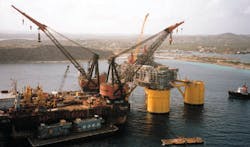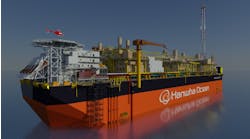New capabilities aim for 10,000 ft depths
John Reed
Heerema
The SSCV Balder is shown lifting modules for Shell's Ursa tension leg platform. The lift vessel will be upgraded to work in water depths up to 10,000 ft.
We have all witnessed the deepwater explosion in the Gulf of Mexico over the past 4-5 years. Not many were prepared for the pace and the breadth of its impact, especially the great water depths at which new projects have been sanctioned.
Just one year ago, Shell was setting records with the Mensa development in about 5,100 ft water depth. Already, Amoco plans the King/Kings Peak development in 6,500 ft water depth. The breadth is likewise impressive and is illustrated by the number of prospects, players, and concepts planned and contemplated.
Tension Leg Platforms (TLP) and Spars are popular with many operators and mini-variations of these are making their way from the drawing board (or screen) to reality. Subsea concepts have also staked a claim and floating production, storage, and offloading vessels (FPSO) are being studied very seriously by the Minerals Management Service (MMS) for US offshore applications.
How will marine contractors cope with the water depths and the foundation concepts, be they suction piles, synthetic rope, and VLAS. And, what about the pipe-in-pipe flowlines and steel cantenary risers? What new installation technologies will be required to work in these deeper depths?
Heerema Marine Contractors (HMC) has installed a long list of TLPs in the Gulf of Mexico. Now, with deeper depths ready for exploitation, the Spar buoy is a new, viable alternative. Recently, in what once was considered deepwater (1,650 ft), a compliant tower was successfully installed for Amerada Hess. While not a record setting depth, it was still quite a challenge for the contractors involved.
FPSOs have long been utilized outside the Gulf of Mexico, but now seem to be garnering extensive interest for ultra-deepwater use in the US Gulf. The contracting strategy in the Gulf of Mexico is also changing along with the concepts. Risk sharing approaches to contracting are almost the norm these days, especially for high-risk deepwater developments.
Operators are seeing their resources constrained, even more so when they have multiple deepwater projects underway that have overlapping schedules. In these situations, they must depend heavily on the contracting industry's resources.
This includes not only manpower, but also management and coordination of work scopes. For the offshore phase of a project, sometimes these work scopes are spread over several contractors. This implies some interface risk which the operators try to minimize by employing risk-sharing agreements.
Alternatively, we now see some operators who prefer a "value added" offshore construction approach, which still achieves a minimal interface risk structure and a low cost. "Value added" means an approach that includes all or essentially all of the offshore construction activities for a total field development.
While no one contractor can normally perform all these activities cost effectively, that firm may be able to offer the best overall cost due to interface risk management and other efficiencies. In other words a contractor who could quickly and cheaply install a wire and anchor mooring system probably cannot install a 5,000-ton topsides.
The "value added" is achieved by offering those scopes which others could perform more competitively at a lower margin and the scopes where he offers the best solution at a higher margin with the added benefit of assuming most of the interface risk. Thus, where the contractor adds value directly, the firm gains profit, and where it does not add value, it still provides a competitive cost and interface risk management to boot.
Heerema's (HMC) strategy for the Gulf of Mexico has been to focus almost exclusively on deepwater projects, especially as a growth sector for our business. The firm is attempting to use its strengths as a basis for implementing a multi-functional approach to deepwater work.
Pipelines/flowlines
In analyzing the market, Heerema realized that pipeline/ flowline installation work would comprise about one-third to one-half the cost of any deepwater installation project budget. The firm's analysis included a look at the full range of deepwater construction activities, such as the installation of suction piles, synthetic moorings, vertical imbedment anchors, Spars, FPSs, TLPs, and templates.As a result of Heerema's findings, the firm decided to provide new capabilities for the semisubmersible construction vessel Balder. Also, Heerema is in the position of being the preferred installation contractor for Amoco's King development. This project will encompass a full range of activities and allow Heerema to equip the Balder with key elements required to execute our strategy.
First, as the King development is in a water depth of 6,500 ft, the vessel will need dynamic positioning. Equally important, an upgrade to the existing J-lay system will be required to lay the anticipated pipe-in-pipe flowlines and export lines. Lastly, the setting of a template in these water depths will require upgrading the crane lowering capability.
Balder upgrading
In general, the vessel's dynamic positioning conversion will consists of the addition of six thrusters powered by the addition of six individual diesel engines and generators. These six thrusters together with the two existing main propellers will provide the necessary stationkeeping capacity for the dynamic positioning of the SSCV Balder.The new thruster system will consist of six 3500kW units which will be installed on the floaters, three per side. The new thrusters are driven by vertically mounted electrical motors installed inside the hull. In addition to the existing engine room, six new engine rooms will be installed on the vessel deck, each with their own diesel-generator set and auxiliaries.
All six diesel-generator sets and auxiliaries will fulfill the redundancy requirements specified by Lloyds Class AAA and NMD Class III regulations. The new engine rooms will be placed port and starboard adjacent to the existing accommodation unit. The six electrical thruster motors are controlled by means of frequency converters, which enable control of the thruster input speed. The frequency control panel will be installed adjacent to the thrusters in the floaters.
The control system will offer fully integrated vessel DP control and will consist of the following main parts: DP computer, supervision control alarm diagnostic automation (SCADA), and thruster unit control. A new control room will be added to the accommodation unit and will contain the control console to suit continuous DP operations and DP manual joystick control.
A separate backup control room will be located elsewhere in the accommodation unit. In general, the one or more of the following positioning reference systems will be installed: GPS, DGPS, tautwire and /or Artemis Mk IV.
For power management three cross-link buses will be installed between respectively three times two engine rooms. This will create the possibility to run two thrusters on one engine during good weather DP operations.
Operationally, the system is designed to cope with stationkeeping for heavy lifting, pipelaying, and transit. The following modes also will be accommodated by the system: anchor assist DP, tugboat assist DP, thruster assist anchoring, and vessel alongside. The system stationkeeping accuracy is set at 1.0-1.5 meter radius during the 95% workability case.
The J-Lay upgrades will consist primarily of the addition of a pipe joint elevating ramp and three new tensioners. The elevating ramp, which is capable of elevating 240-ft joints, will allow for non-critical pipe handling and thus greatly improve cycle times. The new tensioners will each have a holding capacity of 150 tons. The new system will accommodate pipe diameters from 4-in. to 30-in., including pipe-in-pipe designs. Depending on pipe diameters, the system can lay pipe in up to 10,000 ft water depths.
The SSCV Balder's cranes will have their subsea lowering capability enhanced by the addition of winch spooling capacity and new underwater blocks. The resulting capacities will be such that objects weighing up to 1,500 tons can be lowered to 5,000 ft, and objects weighing up to 500 tons can be lowered to 10,000 ft.
In summary, the addition of dynamic positioning combined with the upgraded J-Lay system and enhanced crane lowering capabilities should yield a highly flexible multi-functional vessel.
Copyright 1998 Oil & Gas Journal. All Rights Reserved.




